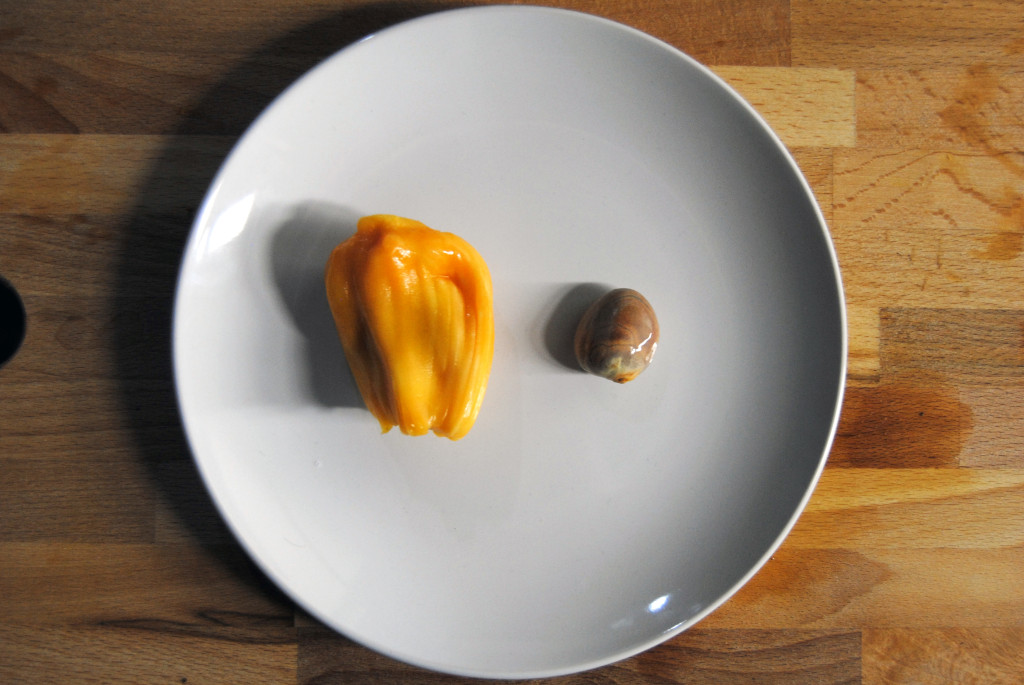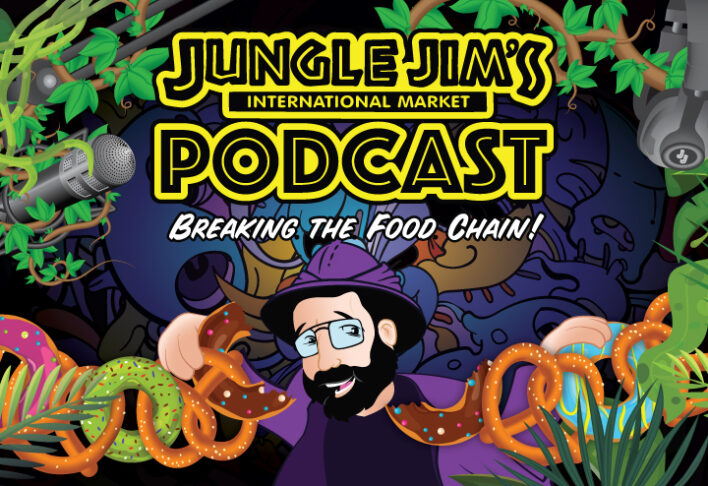
The Foodie Press: Jackfruit
Back to feed- Posted: 9/28/2016
- Categories: Discoveries at the Jungle
Case in point: jackfruit. What started out as a chat about a few of the things that we know we like quickly evolved into a discussion about some of the stranger offerings available in the Jungle Jim’s International produce department, a few of the things we haven’t tried and were genuinely curious about. Jackfruit is a massive, messy, delicious fruit that thrives in tropical climates along the equator. The variety we found was grown in Mexico, but it’s also common in India and other Asian countries. And that was about as much as we knew.
Jackfruit is among the largest fruits found on the planet – a harvested jackfruit is considered small at 12 pounds, with many of them growing significantly larger. Generally picked and harvested in the summer and fall, each oblong, spiny fruit contains bulbs – a lot of them – that are yellow-orange in color, fleshy and fibrous, with a sweetness that’s given away almost immediately by the jackfruit’s strong, distinctive odor. A large seed can be found in the middle of each bulb, also called a pod, and is easily removed by cutting into the bulb itself before taking a bite – you can just pop them out, though the process is a bit… messier. Don’t forget to look for the sheath of the seed, as well, because it does tend to get left behind.
A Note on Preparation:
One of this fruit’s most interesting features is what we suppose is a defense mechanism – the secretion of a thick, white milk, similar in feel and behavior to latex, which all three major components of the jackfruit leak when they’re broken or cut into (those parts being the rind or skin, the fiber surrounding the fruit itself, and the sheath covering the seeds inside). So it can be a sticky mess if you don’t take the right precautions. Since we only had pre-cut pieces of jackfruit available – though they arrive here whole and by the case – much of this particular problem was already taken care of, but should you find and decide to pick up a whole fruit, here are a few things to keep in mind (and this applies to the smaller pieces available at Jungle Jim’s, as well):
- Be sure to protect your hands, but gloves probably aren’t a great idea. Before you cut anything, use a non-flavored, non-scented oil, like a refined coconut oil, to coat your hands.
- Coat your knife with the same kind of oil, because the milky, latex-like secretion is sticky.
- Use lemon slices to staunch the flow of the milk by gently rubbing the lemon along the cuts you’ve made.
Our experience: The first thing we noticed was the aroma. Its pungent, but in a cloying, overly scented rose or strong perfume kind of way, not in an off-putting way. When we bit into the jackfruit, it was obvious why it smelled so strongly, though. This is a sweet fruit, and that sweetness is given away by how strong it’s scent is. But it’s also surprisingly light, and after the first few bites the sweetness calms down quite a bit and you’re left to enjoy a refreshing tropical treat. We recommend finding pieces that are bright yellow, almost orange in color, with the scent still strong but not overpowering. You may see a little browning around the edges, but the lighter the fruit is over all (the less brown for pre-cut segments), the more fresh it’s likely to be.
Of note: It really is as sticky as we anticipated. It’s not necessarily an easy fruit to take apart and gather the edible bulbs from – but that wasn’t really any kind of deterrent. Once we figured out how to remove the fibrous material from around the bulbs, we made quick work of it. We tried both digging into and popping the bulb out, as well as peeling the white fibers away – both worked equally as well. So give yourself some time, and be patient! It’s well worth the effort.
One of the most important aspects of jackfruit is that it isn’t just tasty, it also happens to be packed with a surprising amount of nutritional value. It’s heavy on soluble fiber, meaning it’s good for aiding in digestion and keeping things, shall we say, moving. As well, it boasts significant amounts of vitamins A and C, giving it the power to aid in vision functions and immunity upkeep. Interestingly, it’s high content of B vitamins makes it somewhat of a rarity in the fruit world, so eating jackfruit can give you a little boost of energy for those days when it’s a little more difficult to get going.
It’s hard to wrap our heads around just how interesting and truly unique this fruit really is. From it’s size, to its preparation, to it’s smell and even feel, it’s a big fruit with alot of character. And since it can be prepared in more than a few different ways, or used as an ingredient in several kinds of dishes, it has so much to offer. You can use it as an ingredient in both ice cream and soups. Even its seeds can be used several ways. It turns out this is a remarkably versatile fruit – easy to grow and maintain in the right climate, with the trees themselves a source of strong, rot resistant wood. Jackfruit is routinely made into chips, roasted, and juiced (though, you probably don’t want to do all of those at the same time).
Jungle Jim’s carries a few different varieties of jackfruit chips (a favorite among The Foodie Press team), both on their own and in a mix, which can be found in the Taiwan section. There’s a kind of preserved, jarred jackfruit in syrup (think canned or preserved, peaches), canned jackfruit in syrup, and a chewy, milky jackfruit candy, all found in the Philippine section of the Asian department. In the frozen section of the Asian department, you can even find jackfruit popsicles and ice cream (which we’re excited to try!). So like we said, this is a fruit that’s great on it’s own, but can be enjoyed in quite a few different ways.
We’re happy we tried jackfruit, and were genuinely surprised by both how unique it is, and also how accessible it turned out to be (that is, once we figured out what to do with it). It really is quite wonderful, and imagine you’ll have just as much fun exploring this big, weird, delicious fruit as we did.







